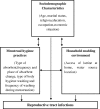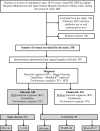Association between unhygienic menstrual management practices and prevalence of lower reproductive tract infections: a hospital-based cross-sectional study in Odisha, India
- PMID: 30241498
- PMCID: PMC6150969
- DOI: 10.1186/s12879-018-3384-2
Association between unhygienic menstrual management practices and prevalence of lower reproductive tract infections: a hospital-based cross-sectional study in Odisha, India
Abstract
Background: The extent to which reproductive tract infections (RTIs) are associated with poor menstrual hygiene management (MHM) practices has not been extensively studied. We aimed to determine whether poor menstrual hygiene practices were associated with three common infections of the lower reproductive tract; Bacterial vaginosis (BV), Candida, and Trichomonas vaginalis (TV).
Methods: Non-pregnant women of reproductive age (18-45 years) and attending one of two hospitals in Odisha, India, between April 2015 and February 2016 were recruited for the study. A standardized questionnaire was used to collect information on: MHM practices, clinical symptoms for the three infections, and socio-economic and demographic information. Specimens from posterior vaginal fornix were collected using swabs for diagnosis of BV, Candida and TV infection.
Results: A total of 558 women were recruited for the study of whom 62.4% were diagnosed with at least one of the three tested infections and 52% presented with one or more RTI symptoms. BV was the most prevalent infection (41%), followed by Candida infection (34%) and TV infection (5.6%). After adjustment for potentially confounding factors, women diagnosed with Candida infection were more likely to use reusable absorbent material (aPRR = 1.54, 95%CI 1.2-2.0) and practice lower frequency of personal washing (aPRR = 1.34, 95%CI 1.07-1.7). Women with BV were more likely to practice personal washing less frequently (aPRR = 1.25, 95%CI 1.0-1.5), change absorbent material outside a toilet facility (aPRR = 1.21, 95%CI 1.0-1.48) whilst a higher frequency of absorbent material changing was protective (aPRR = 0.56, 95%CI 0.4-0.75). No studied factors were found to be associated with TV infection. In addition, among women reusing absorbent material, Candida but not BV or TV - infection was more frequent who dried their pads inside their houses and who stored the cloth hidden in the toilet compartment.
Conclusion: The results of our study add to growing number of studies which demonstrate a strong and consistent association between poor menstrual hygiene practices and higher prevalence of lower RTIs.
Keywords: Bacterial vaginosis; Candidiasis; Menstrual hygiene management; Reproductive tract infections; Trichomonas vaginalis.
Conflict of interest statement
Ethics approval and consent to participate
The study was approved by the Institutional Review Board of Asian Institute of Public health (AIPH) [ERC/No: 2013–03], Ispat General Hospital, Rourkela [Regd No: ECR/369/Inst/OR/2013], and the Ethical Committee of Government of Odisha [No: 237/SHRMU]. The study was also approved by the Ethics Committee of the London School of Hygiene and Tropical Medicine [LSHTM ethics ref.: 6520]. Only those women who provided written informed consent to participate in the study were included.
Consent for publication
Not applicable.
Competing interests
The authors declare that they have no competing interests.
Publisher’s Note
Springer Nature remains neutral with regard to jurisdictional claims in published maps and institutional affiliations.
Figures


References
-
- Marni S, Sahin M, Paloubis L, Truong M, Sinden J. New York. 2016. WASH in schools empowers girls’ education: proceedings of the menstrual hygiene Management in Schools Virtual Conference 2015, United Nations Children’s fund and Columbia University.
MeSH terms
LinkOut - more resources
Full Text Sources
Other Literature Sources
Miscellaneous

